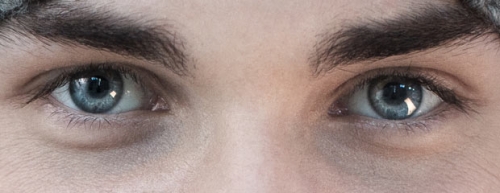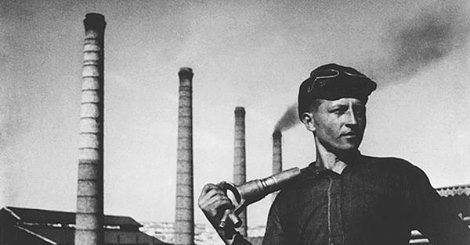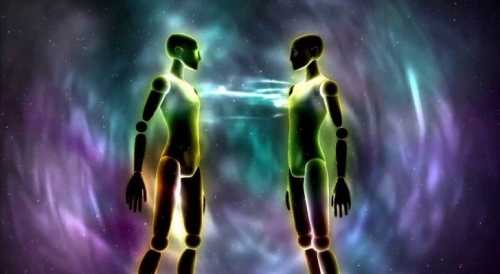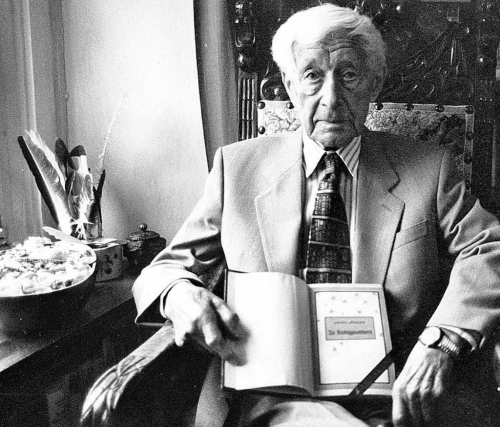Jünger saw in the figure of the Arbeiter the central category around which the modern world, subjected to the planetary domination of technology, was called to organize itself, in “total mobilization” though and in labor. More precisely, a response adapted to the rise of nihilism in the modern era could be deployed through the technological mobilization of the world. With it, he salutes the advent of a new figure of man, modeled on the Nietzschean superman.
Among the adepts of Marxist ideology, very few have analyzed the thought of those they call “pre-fascist”, or outright “fascist”, including Ernst Jünger, who would evidently be one of the figureheads. Armin Steil is one of the rare Marxist ideologues who has analyzed the paths of Georges Sorel, Carl Schmitt, and Ernst Jünger with pertinence, depth, and especially clarity in his work Die imaginäre Revolte : Untersuchungen zur faschistischen Ideologie und ihrer theoretischen Vorbereitung bei Georges Sorel, Carl Schmitt und Ernst Jünger (The Imaginary Revolt: Inquiries on Fascist Ideology and its Preparation with Georges Sorel, Carl Schmitt, and Ernst Jünger).
Focusing on Der Arbeiter, Steil notes that Jünger’s logic, starting from his “fascism” or more precisely his “revolutionary conservatism,” is not a theoretical logic, a constructed logic, based on the observation of causes and effects, but a metaphorical, poetic, imagistic logic and language. Facing a chaotic socio-economic and political reality, facing the crisis of German society and culture, Jünger wanted to master its perverse effects, its dysfunctions through aesthetics: so his “fascism,” his “revolutionary conservatism,” would essentially be aesthetic in nature, contrary to Marxism, which molds itself on material realities and resolves crises by operating on socio-economic matters themselves, without idealist recourse, without recourse to transcendence or to an aesthetic. Steil very justly concludes: “The book [Der Arbeiter] wants to teach [men] to have a sovereign attitude in the face of social attitudes.” Cold, dispassionate, microscopic observation thus forms the “magic key” that would permit an elite to master the crises, to put an end to chaos and the corrosive disparities that hinder the proper functioning of societies that are subject to them.

To be Hyper-Perceptive Eyes
The willing spirits that thus desire “to take the bull by the horns,” to act on the political terrain, to fight against crises and their effects, should not bind themselves to building a mechanical system of ready made ideas that perfectly match and fit together, but should be hyper-perceptive “eyes,” capable of describing the phenomena of everyday life: what Jünger calls the “physiognomic method.” It allows one to see the essence of a thing in its simple appearance, grasping the unity of essence and appearance, which is the “form” (Gestalt), invisible to all inattentive, distracted observers, not used to wielding the “physiognomic method” with the desired dexterity. All valuable, fruitful phenomena thus bear in themselves a “form,” more or less hidden, a potential force that it captures and puts in the service of a political or historic project. On the other hand, every phenomenon that only appears as “normal” is consequently a phenomenon without further “form”, without “force.” Such a phenomenon would be an early warning sign of decadence, a sign indicating a reshuffling of the cards, forms die, thus obeying a hidden logic, which prepares the advent of new forms, of unbroken forces.
The observation of the phenomena of everyday life, of the details of our daily settings, gives a glimpse of where the fall and death of forms manifest themselves: neon, garish lights, loud and artificial modern cities, are a patent indication of this fading of forces, masked by colors and intensities without real life. Modern traffic in the big cities burdens the pedestrian, the only physical being in this universe of concrete, asphalt, and metal, on the barely tolerated margins are the sidewalks, tracks reserved for the “least speedy.”

The “Arbeiter” uses the “Physiognomic Method”
So the “Arbeiter” is the figure that makes use of the “physiognomic method,” observes, deciphers, plunges into this universe of artifice to seek buried forces, in order to mobilize them for a purely imagined project, “Utopian” in the Marxian and Engelsian sense of the term, Steil explains. This recourse to the imaginary, as the Marxist Steil explains, proceeds from a logic of doubt, which aims to give meaning to that which does not have it, at any cost. It aims to convince us that behind the phenomena of decline, of de-vitalization, an “Order” and laws emerge, which are avatars of the one God refused by the advocates of historical materialism. This “Order”, this Gestalt, this “form”, integrates the infinite diversity of observations posed by people, but it is not, like in the case of historical materialism, a reflection of social relations, but rather a total vision, intuitive, going directly to the essence, that is to say the original form. It is not the objective and positive enumeration of causes and effects that allows one to decide and act, but, on the contrary, a piercing look what allows one to see and grasp the world as the theater where forms confront or cooperate with each other.
The “Arbeiter” is precisely the one who possesses such a “piercing look”, and who replaces the bourgeois, who reasons strictly in simple cause and effect. Steil notes the gap between this vision of the “Arbeiter” and the Marxist and empirical vision of the “Proletarian”: the figure forged by Jünger places himself high above socio-economic contingencies; while the proletarian conscious of his dereliction operates at the heart of these contingencies, without taking any distance, without detachment. The “high flight” of the Arbeiter, his aquiline perspective, gives him a mask: metallic or cosmetic, the gas mask of the combatant, the drivers helmet with the men, makeup with the women. Individual traits disappear behind these masks, as should individual human, all too human, imperfections disappear. The figures of the Arbeiter are certainly imaginary figures, excessively idealized, de-individualized and examined: they act like Prussian soldiers in the Frederician era of practice. Following their leaders, these lesser (but nevertheless necessary) avatars of the Arbeiter and the Prussian soldiers from the “war in lace” [Translator’s note: referring to the ornate uniforms worn by soldiers of the 17th and 18th century] certainly lose the imperfections of their individuality, but also abandon their doubts and disorientation: rules and Order are safety anchors offered by the new elite community of “Arbeiters,” virtuosi of the “physiognomic method.”

The Apparent Independence of the Proletarian
Steil protests that Order, as an imaginary projection, and the “physiognomic method” are instruments against the empirical and Marxist notion of “class struggle,” before clearly giving Jünger’s version: to leave the laborer, the worker, in the grasp of socio-economic contingencies is to leave him in a world entirely determined by the bourgeoisie, arising from the bourgeoisie and ultimately controlled by the bourgeoisie. By occupying a designated place in the bourgeois order, the worker only enjoys an apparent independence, he has no autonomy. Every attack launched against the bourgeois order from this apparent position is also only apparent, destined to be recollected and reinforce the establishment. “Theoretically, every move takes place in the context of an outdated social and human utopia; practically, each brings to dominion, time and again, the figure of the clever business man, whose art consists in bargaining and mediating,” writes Jünger. For Steil, this definition radicalizes the Sorelian vision of socialism, which desires to transform politics into pure means, without a limiting objective, inscribed in contingencies.

To Restore “Auratic” Work
A Marxist will see, in this idealism and in this purification of politics as pure means, an eliminations of politics, a will to put an end to the destructive violence of politics, which is only, in the Marxist view, “class struggle.” But technology operates to sweep away the dead forms in order to establish new forms following a planetary confrontation of extant forms, still endowed with more or less intact forces. So technology destroys residual or obsolete forms, it makes the permanent war of forms planetary and gigantic, but the “Arbeiter,” by coldly instrumentalizing the “physiognomic method,” gives a final form to technology (a desire that is never realized!). This final form will be artistic and the beauty emerging from it will have a magic and “sacral” function, like in so-called “primitive” societies. The restoration of these forms, writes Steil, will be achieved through the restoration of “auratic” work, eclipsed by technological standardization. The Aura, the impalpable expression of form, of the essence of represented phenomenon, restores the sacred dimension, proclaims the return of the cult of beauty, by qualitative replacement of the dead religiosity from the bourgeois era.
“Heroic realism,” the foundation of the new socio-political Order, will be carried by a dominant caste simultaneously exercising three functions: that of retainer of knowledge, that of new warrior forged during the battles of material in the Great War, and that of producer of a new aesthetic, a medium integrating social differences.
Armin Steil, in his Marxist critique of the “pre-fascism” of Sorel, Jünger and Schmitt, clearly lays out the essence of a work as capital as Der Arbeiter, where the mania for fabricating systems is refused in favor of great idealist affirmations, disengaged from the overly heavy contingencies of bourgeois society and proletarian misery. The Jüngerian path, in this view, appears as a disengagement from the yoke of the concrete, as a haughty retreat ultimately leading to a total but external domination of this concreteness. But in the piercing look, demanded by the physiognomic method, is there not, on the contrary, an instrument to penetrate concreteness, much more subtle than simple surface considerations of phenomena?
Reference: : Armin STEIL, Die imaginäre Revolte. Untersuchungen zur faschistischen Ideologie und ihrer theoretischen Vorbereitung bei Georges Sorel, Carl Schmitt und Ernst Jünger, Verlag Arbeiterbewegung und Gesellschaftswissenschaft, Marburg, 1984





 del.icio.us
del.icio.us
 Digg
Digg